Plant Disease: Oleander Leaf Scorch
Love them or hate them, oleanders have a firm foothold in the desert landscape where they are usually seen creating living green ‘walls’ in order to provide privacy.
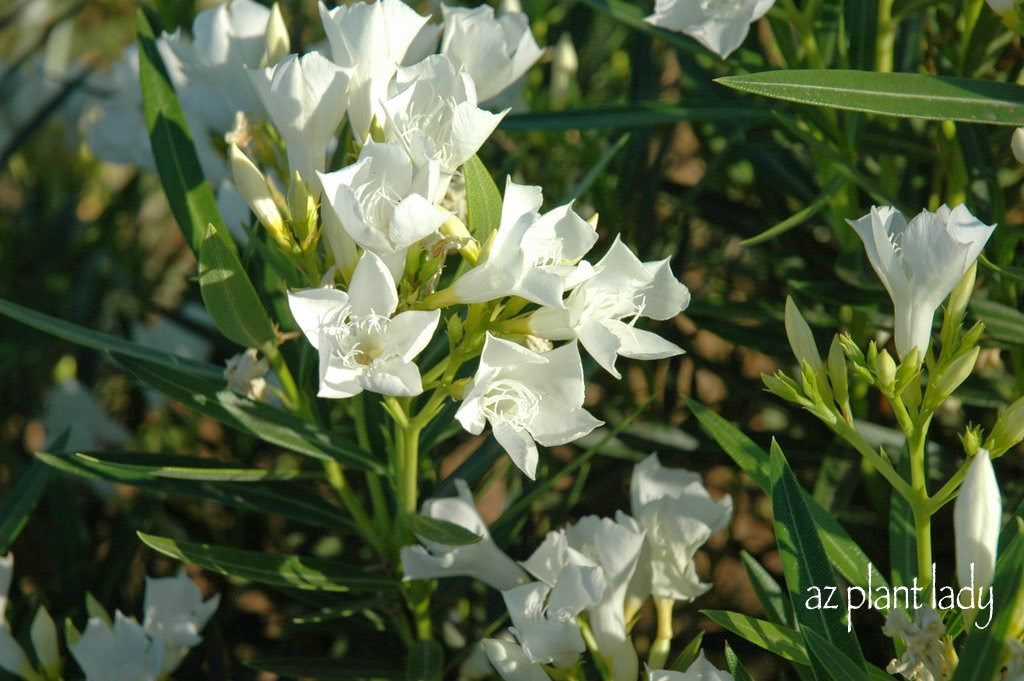
Their popularity is due in large part to several characteristics:
– Their evergreen foliage provides the rich, dark green color many miss living in the desert.
– Oleanders are easy to grow, with little to no fertilizer, and are drought tolerant once established.
– They add beauty to the landscape spring through fall with their flowers.
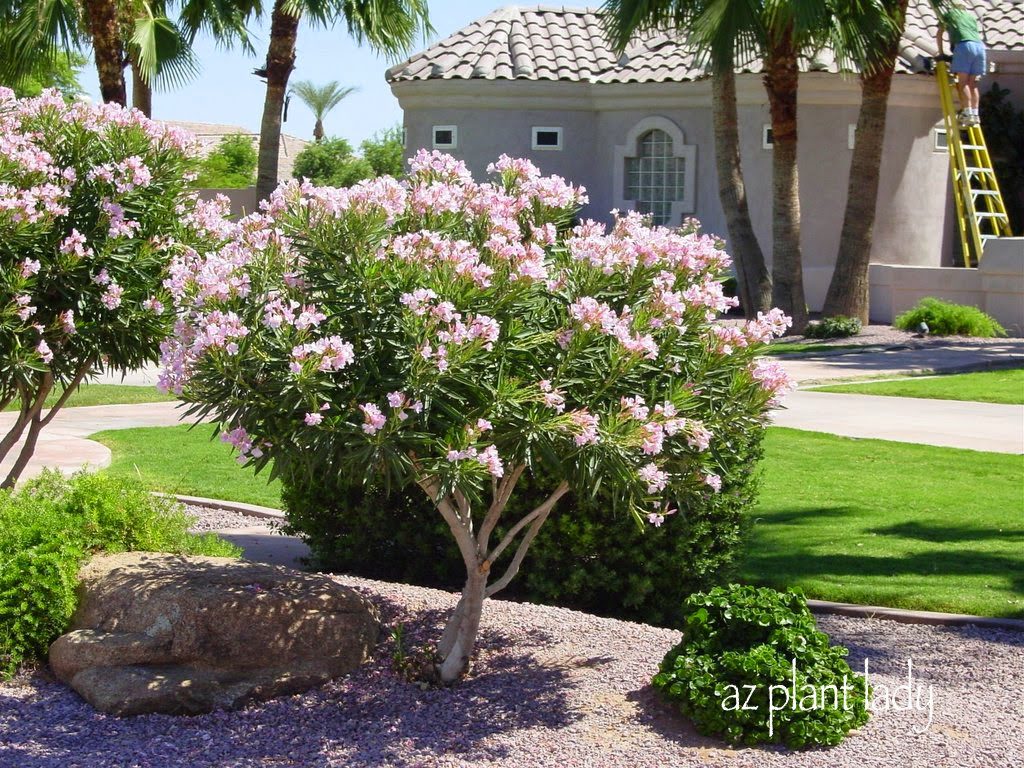
While oleanders’ popularity is still holding on, a fatal disease that affects them has spread from California and is now being seen increasingly in Arizona.
Oleander leaf scorch (Xylella fastidiosa) is a bacterial disease that plugs up the vascular system of affected oleanders, eventually making the movement of water throughout the plant impossible.
Flying insects, called sharpshooters, spread this disease. These small insects (1/4 inch long) become carriers of the disease when they feed upon an infected oleander. Thereafter, they spread it to every other oleander they feed upon.
Oleanders in Southern California were first diagnosed with the disease in the early ’90s, and it was just a matter of time before it spread to Arizona.
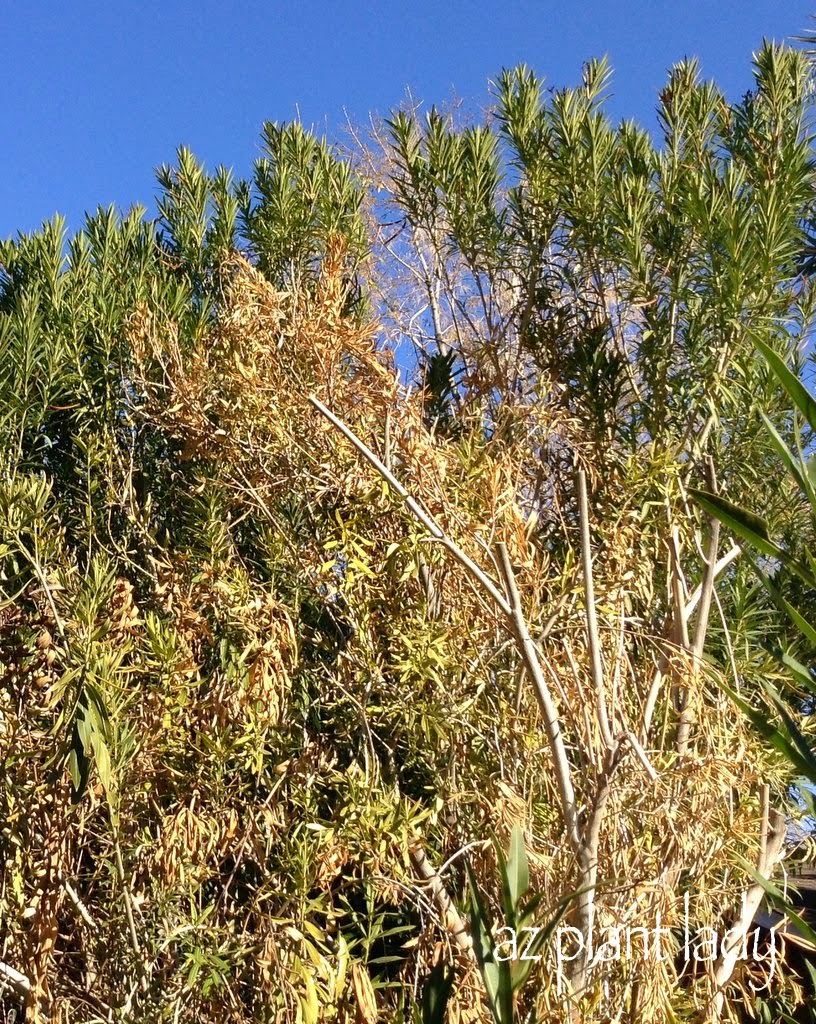
Advanced stages of oleander leaf scorch
Oleander leaf scorch was first diagnosed in Arizona in 2004. Its spread has been slow but inexorable.
I have seen several cases of this disease during landscape consultations, including one I did yesterday.
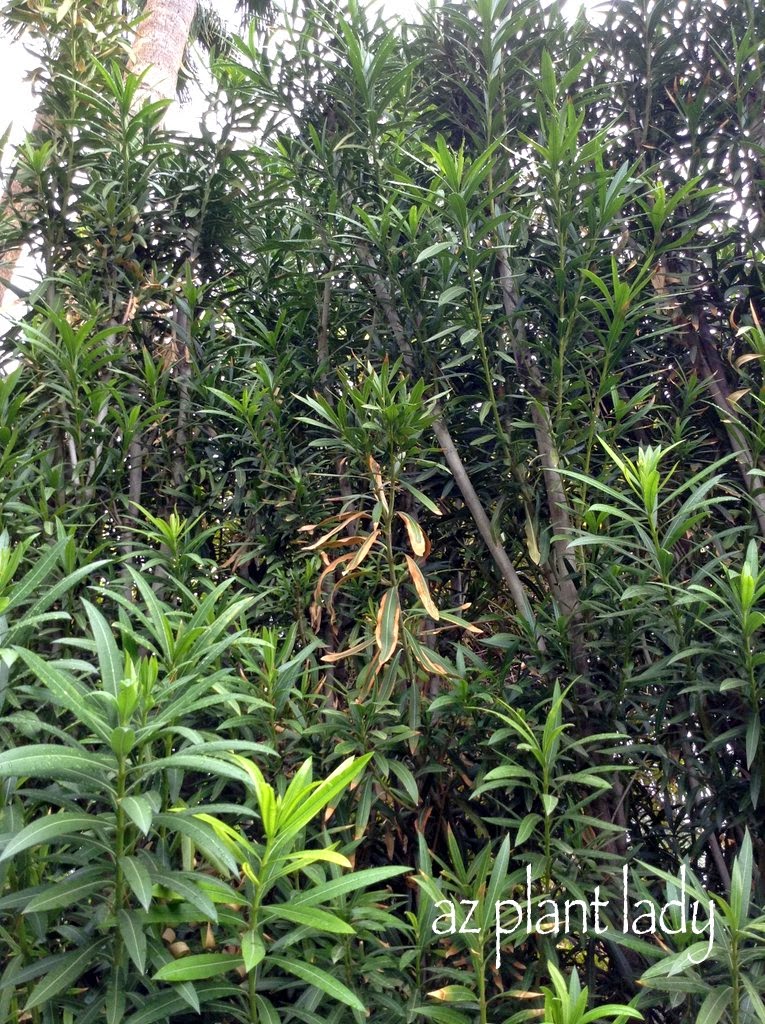
The homeowner had a very large, over 20-year-old oleander hedge that provided privacy from his neighbors.
What may look like some browning leaves on this small branch is one of the classic symptoms of oleander leaf scorch.
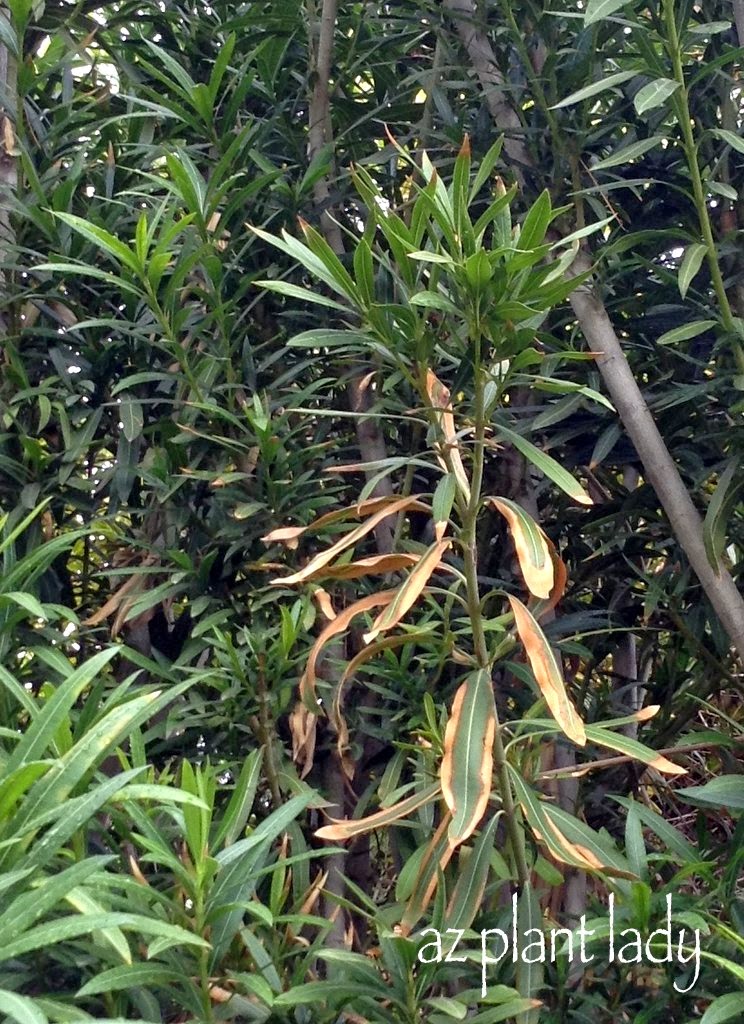
Oleander leaf scorch
In a close-up, you can see the brown outer leaf margins, which are characteristic of oleander leaf scorch. (This is not to be confused with drought symptoms, which cause discoloration of the middle of the leaf.)
As we continued to walk along the row of oleanders, the infected oleanders were interspersed between healthy ones. The reason for this is that the nature of flying insects is that they hop from one plant to another, but not necessarily the next plant – they may fly three shrubs away before feeding again or to the next yard or block.
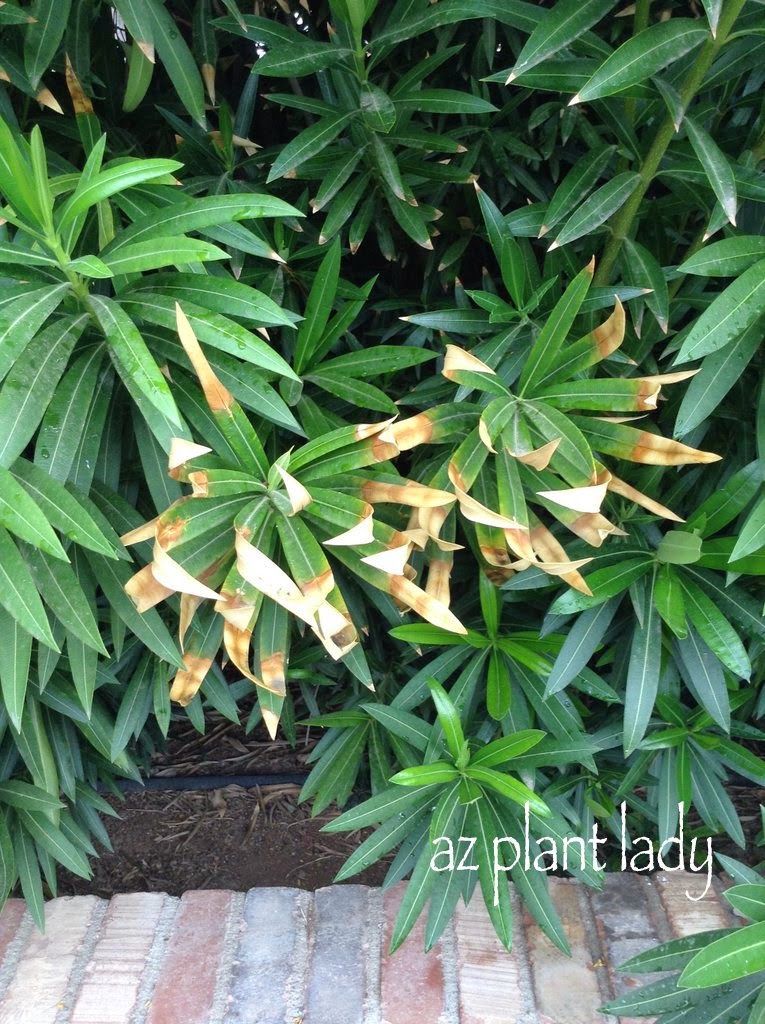
Symptoms of oleander leaf scorch
This oleander showed another type of browning symptom of oleander leaf scorch with the tips looking ‘scorched’.
It’s important to note that salt burn resulting from drought or shallow irrigation can cause similar symptoms, as shown in the photo below:
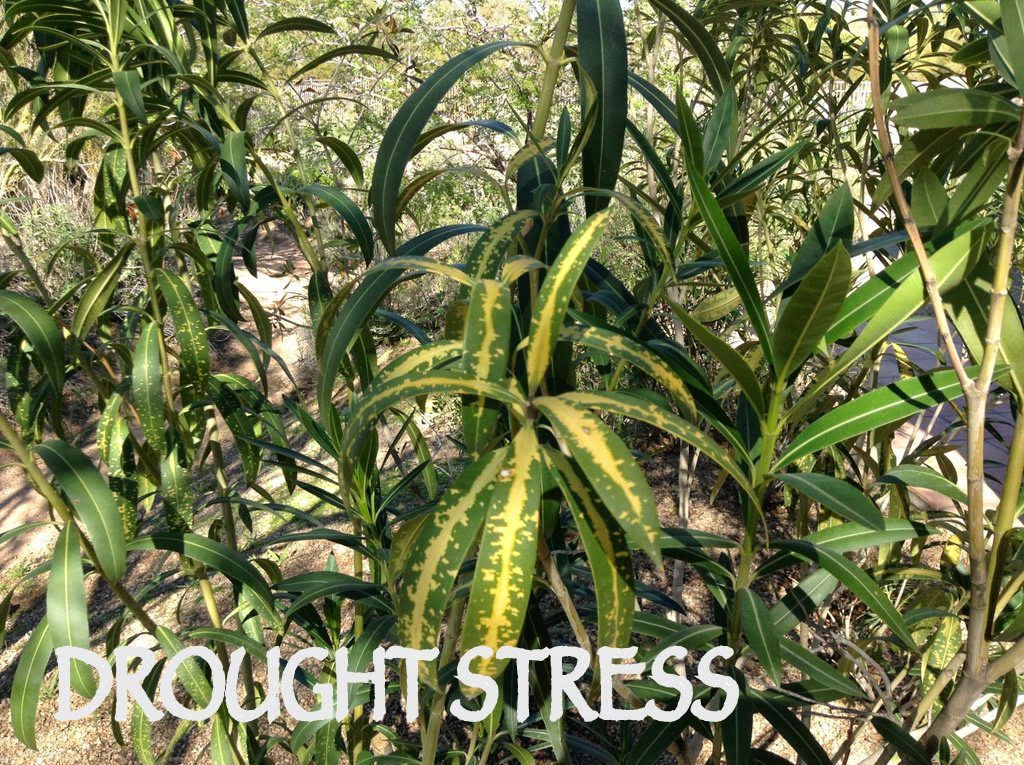
Drought-stressed oleander leaves
Note that the middle of the oleander leaf is affected by drought stress. While unsightly, the oleander pictured above does NOT show signs of oleander leaf scorch.
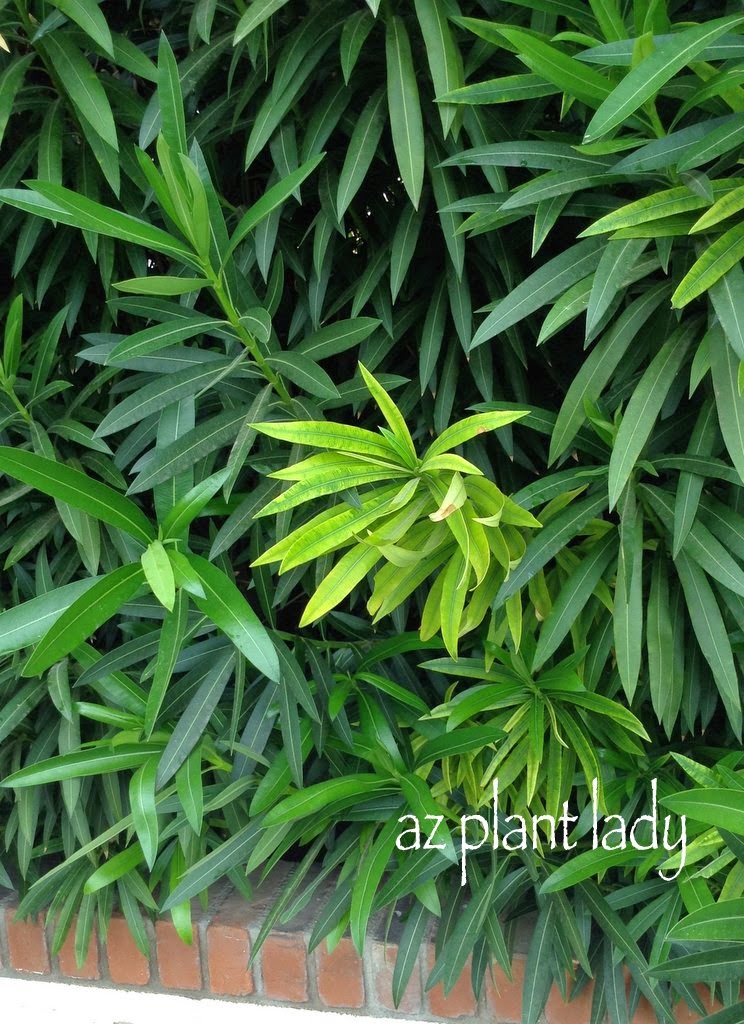
Initial signs of oleander leaf scorch.
Back to the oleanders showing signs of oleander leaf scorch – I could see the beginning of symptoms with lighter green alongside darker leaves by looking closely at seemingly healthy oleanders. The signs of the disease don’t show up all at once initially. Often, it starts with a branch here and there showing signs initially that will gradually progress throughout the entire plant.
It’s important to note that once an oleander has been infected with this disease, the entire plant has it—not just the branches that initially show the first signs. When oleander leaf scorch first showed up, it mainly affected large oleander shrubs, but in recent years, it has also been seen in dwarf species.
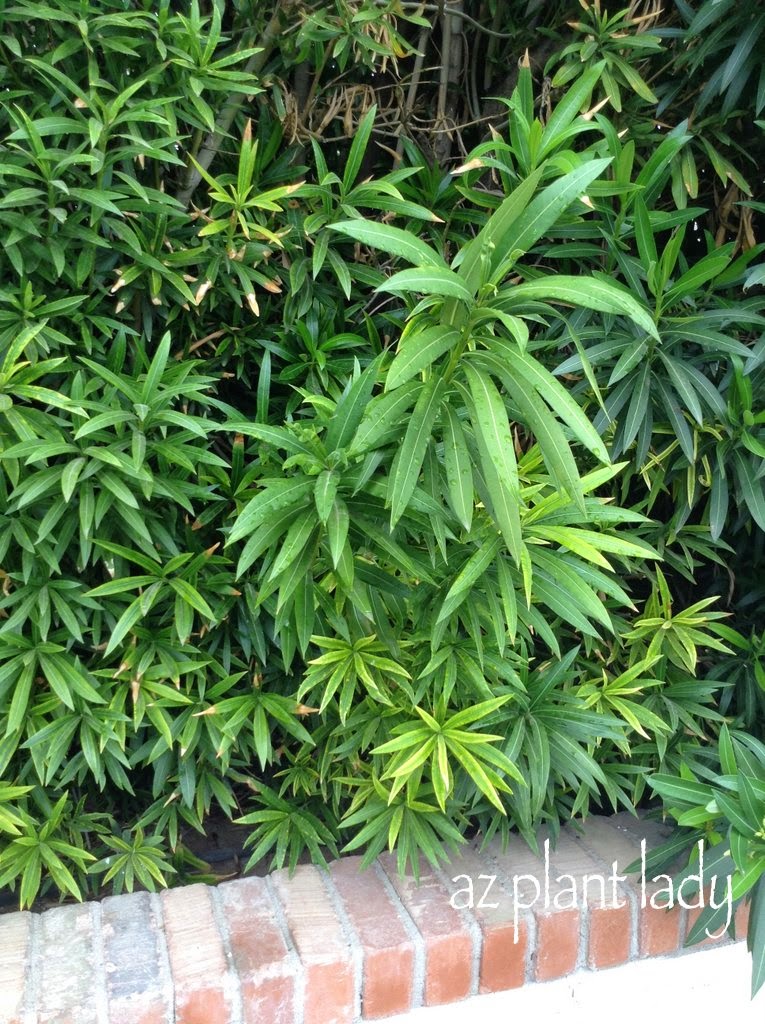
Lower leaves showing the beginning symptoms of oleander leaf scorch.
So, what is the treatment for oleander leaf scorch? Sadly, there is no cure, and once infected, it will eventually kill oleanders over a 3 – 5 years.
Some experts recommend pruning out affected branches to improve the appearance of infected oleander shrubs for the short term, but the shrubs will die.
I recommend removing infected oleanders right away to help keep the disease from spreading.
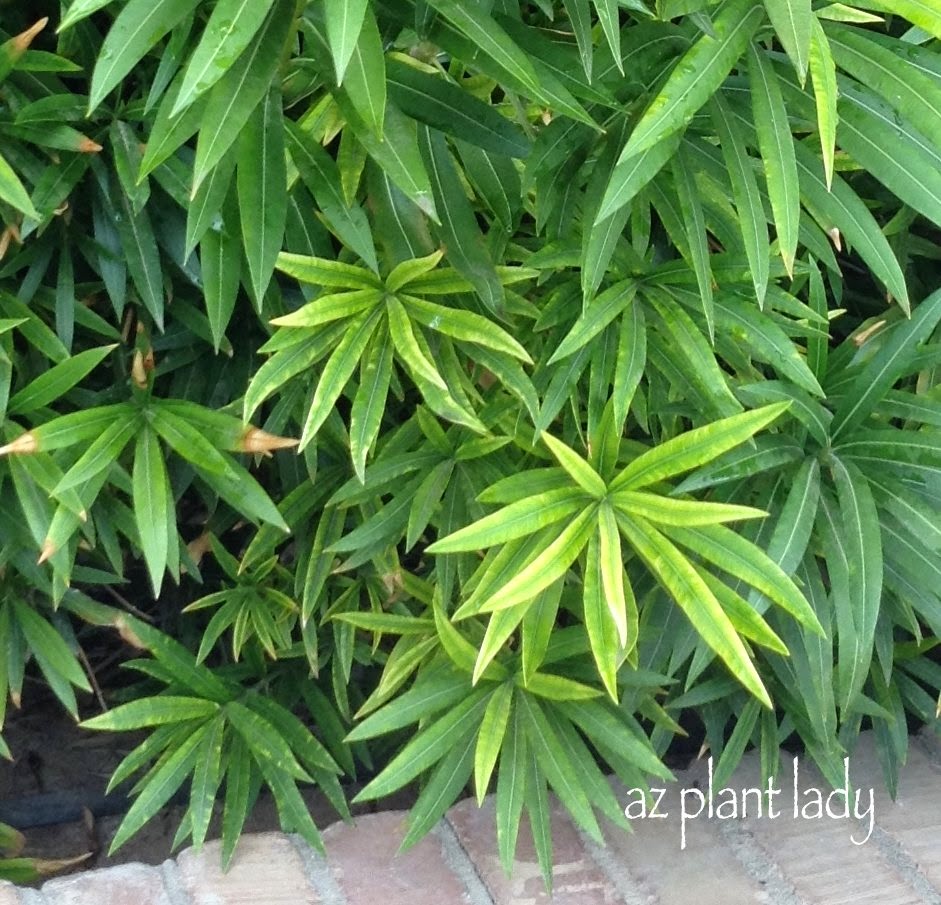
Initial signs of oleander leaf scorch
Consult with an expert if you suspect that your oleanders are infected. Problems with irrigation, nutrient deficiency, and salt burn can mimic some of the symptoms of oleander leaf scorch, and a horticulturist or other landscape expert can help you rule out other causes. Ultimately, positive identification of oleander leaf scorch can only be made by lab tests through your local cooperative extension office.
Can you get rid of the infected oleanders and start over with new ones? The answer is “no.” The disease is already present in the local sharpshooter insect population, and it is only a matter of time before it infects your new oleander shrubs.
I recommend using Arizona rosewood (Vauquelinia californica) or hopbush (Dodonaea viscosa) as an alternative to oleanders. Both are evergreen, recommended for use near pools, make a great hedge, are drought tolerant, and attractive.
For more information on oleander leaf scorch, you may want to check out the following links:
Leaf Scorch Management Guidelines
Oleander Leaf Scorch Strikes Again…

 Noelle Johnson, aka, 'AZ Plant Lady' is a author, horticulturist, and landscape consultant who helps people learn how to create, grow, and maintain beautiful desert gardens that thrive in a hot, dry climate. She does this through her consulting services, her online class Desert Gardening 101, and her monthly membership club, Through the Garden Gate. As she likes to tell desert-dwellers, "Gardening in the desert isn't hard, but it is different."
Noelle Johnson, aka, 'AZ Plant Lady' is a author, horticulturist, and landscape consultant who helps people learn how to create, grow, and maintain beautiful desert gardens that thrive in a hot, dry climate. She does this through her consulting services, her online class Desert Gardening 101, and her monthly membership club, Through the Garden Gate. As she likes to tell desert-dwellers, "Gardening in the desert isn't hard, but it is different."
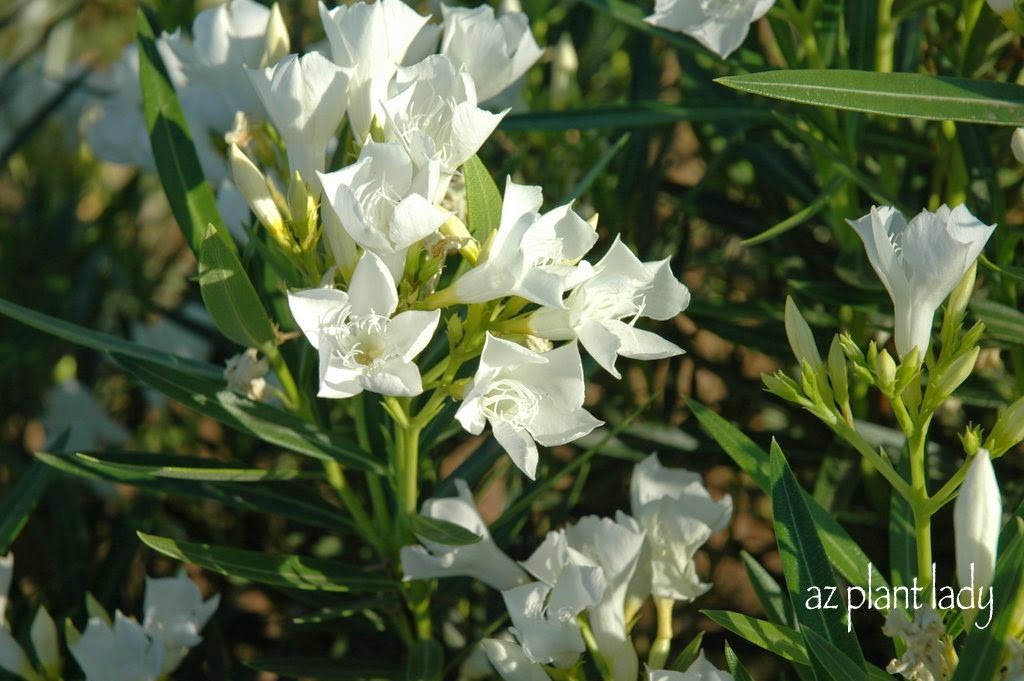
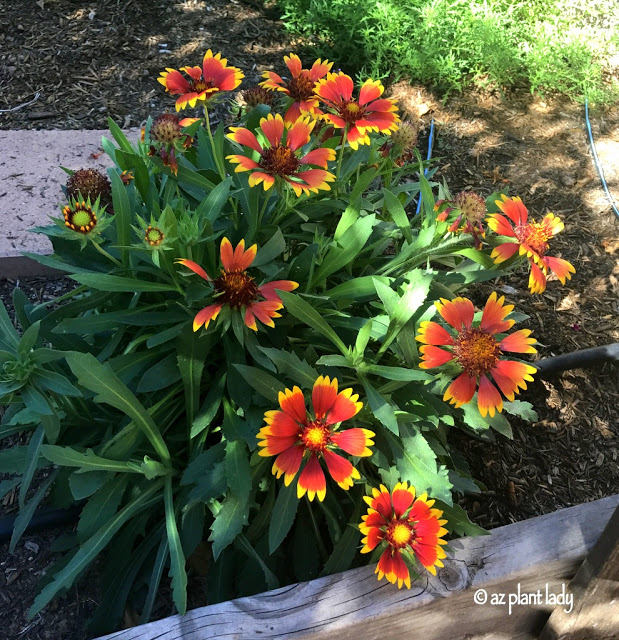
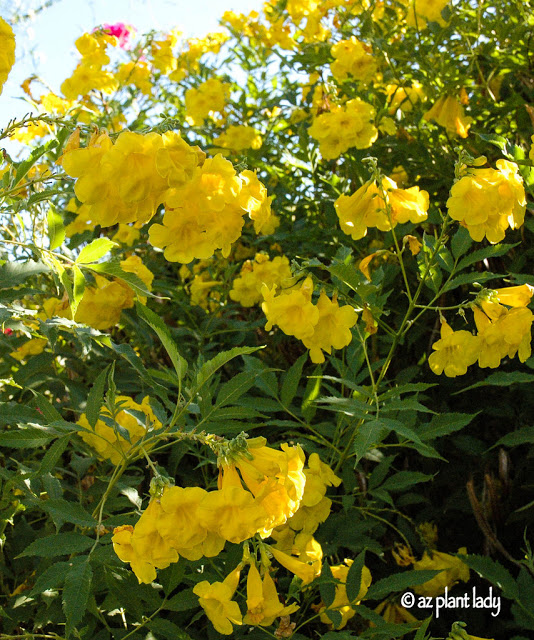
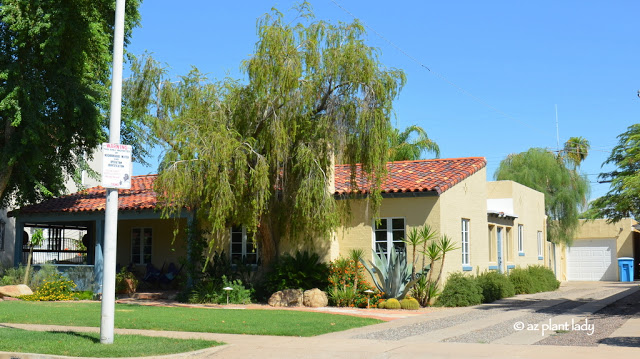
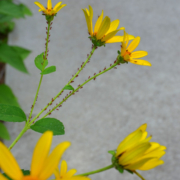

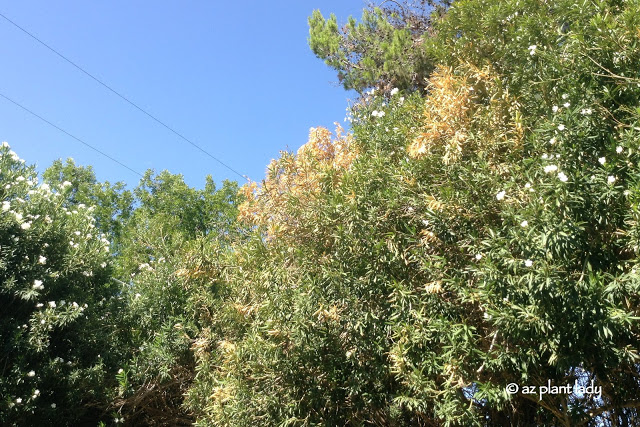






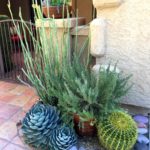

I was just wondering about my own oleander trees, in Gilbert. They both seem to be dropping a significant number of yellow leaves and blossoms right now. Upon investigating the trees, it appears the outter leaves are bright and nice, but just below that there are mottled light green and yellow leaves, and also many leaves having dry, brown leaf tips. I am wondering if it has to do with them being trimmed about 6-8 weeks ago, or something else. I think I am going to takea walk around the neighborhood and check out the other oleanders for comparison. Hope its not that disease- I rent and don't want to have to dig out trees or replace them! What do you think about the leaves?
Hello Lesley,
Chances are that your oleanders are probably fine. It's normal to see some yellowing leaves and a few brown leaf tips. Also, I don't think that oleander leaf scorch has spread to Gilbert yet, to my knowledge.
Noelle
Thank you!
Noelle, can oleanders be cut back too much during our hot AZ summers?
Last week, our landscaper cut ours way back and instead of pruning them back a third, he cut them back more than half. The oleanders on the west side of the house have branches that are bare and exposed to the hot sun.
With our record breaking temps this year, what are the chances they'll survive?
Thanks,
Syl
Hello Sylva,
Your oleanders should be just fine. What your landscapers have done is to do renewal pruning, which gets rid of old, woody branches that produce fewer leaves and flowers. This type of pruning is typically done every few years to rejuvenate shrubs and is a practice that I recommend.
Your oleander shrubs should be fine and grow back. If one or more doesn't grow back, that is usually a sign that they were already declining and would have most likely died eventually whether or not they had been severely pruned.
Make sure that they are receiving water to help them to grow back.
I hope this helps!
Best,
Noelle – AZ Plant Lady
Thanks for your reply, Noelle. I sure hope they make it through the summer. The oleanders were blooming beautifully before the landscapers hacked away at them and laid all the branches bare.
I asked them to do only a light trim right now because of the extreme heat, and then do a renewal pruning at a cooler time of year. Unfortunately, I wasn't watching closely enough before he severely pruned them. Even though I am watering the oleanders regularly, some branches have dried out completely and snap when bent.
What's ironic is that I hired this company because they told me they understood my desire to keep our garden natural and said they would hand cut/trim. I paid extra to have them hand trim our bushes. Like you, I intensely dislike the "poodle cuts," "lion's tail" and "cupcake style" that many people choose. Unfortunately, in this case, their hand cutting tools also included a set of lopers.
I live in central Phoenix. I noticed that from 7th Street going East on Osborn along the Phoenix Country Club the oleanders, which have been dying for some time now, were being removed and it appeared that they were replacing them with oleanders with the red-pink blossom. I had also heard from other sources that the red-pink blossom plants are not being infected? Any truth to this?
Thank you!
Hello Mike,
Great question. From what I have heard from fellow landscape professionals, oleander leaf scorch hasn’t affected the dwarf species of oleander. I’m not sure if the red/pink blossoms plants you are speaking of are dwarf, or if they are the large species, are resistant due to some unknown factor.
Has leaf scorch made it to Tucson? My neighbor and I shade a very old hedge. About half of our plants died suddenly, although it’s possible it was due to lack of watering, since both of us had been ignoring the hedge, or due to a chemical spill on his side. It’s unclear the cause. The remaining side of the hedge has some leaf scorch symptoms here and there, but as you said, it could be something else.
Hi Josie,
I haven’t heard of it in Tucson, yet. I did see an article that stated that as of 2011 it hadn’t made its way to Tucson yet. I would talk to your local cooperative extension office to see if there have been any cases.
Hello,
What do you do for the oleander if you think it may be the other reasons it’s turning brown. How do I know if I’m watering too much or too little? I recently purchased a home in Goodyear with a row of huge bushes that were green and full of flowers two months ago. They are now about 50% brown but are producing seed pods. I’m not sure what to do but all the other oleanders on the property are thriving.
Hello Brian,
I haven’t heard of oleander leaf scorch showing up in Peoria yet, so that’s good. Deep watering for shrubs is important to a depth of 18-24 inches. I recommend following the schedule put forth by the folks at Water Use It Wisely – go with the shorter interval for higher-water use shrubs for now and later, modify it toward the longer interval this fall. https://wateruseitwisely.com/wateringguideflipbook/
I hope this helps!
Hello Noelle, we live in Fountainhills and are in quite a dilemma, our new landscaper for our complex recently has determined that our oleanders are suffering from the scorch disease, apparently he tested through a lab and confirmed to our board( condo complex) of the problem, however from Early May until late summer we were not able to water any plants due to Epcor replacing water lines, my oleanders in the rear of my condo look healthy. The board and this landscaper can’t really determine whether ,if in fact , my particular ones are infected. Our oleanders in the rear are approximately 10-12 feet tall and full of green leaves , with some signs of brown tips( but not much) The oleanders that were tested are in the west end of the complex And are much smaller in height (4 feet) And 250 feet away. The board wants to either cut them down to ground and see if they return healthy or pull all of them out at a very expensive cost with heavy machinery, any thoughts? Sorry this was so long Reg Hernandez
Hello Reg,
This is a complex problem. If oleanders are infected, then there is nothing (known to date) that can cure them, so pruning back severely shouldn’t make a difference. The insect that causes this hops from shrub to shrub so it’s not unusual for there to be some unaffected amidst those that are. However, over time usually, all will succumb as the leaf hopper insects will feed on the infected oleanders, spreading the disease to healthy ones. I’m sorry you and the residents in your complex are having to deal with this problem.